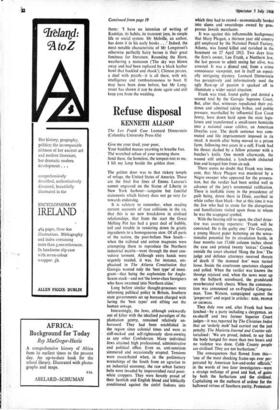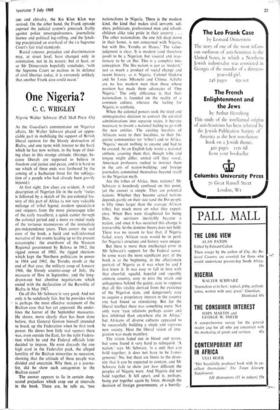Refuse disposal
KENNETH ALLSOP
Give me your tired, your poor, Your huddled masses yearning to breathe free, The wretched refuse of your teeming shore. Send these, the homeless, the tempest-tost to me, I lift my lamp beside the golden door.
The golden door was to that rickety temple of refuge, the United States of America. Those are the final five lines of Emma Lazarus's sonnet engraved on the Statue of Liberty in New York harbour—sanguine but fanciful statements which history does not go very far towards endorsing.
It is salutary to remember, when reading current accounts of race collisions in the us, that this is no new breakdown in civilised relationships, that from the start the Great Melting Pot has had a great deal of bubble, toil and trouble in rendering down its gristly ingredients to a homogeneous stew. Of all parts of the nation, the post-belltun New South— when the railroad and cotton magnates were attempting there to reproduce the Northern industrial matrix—went through the most con- vulsive torment. Although extra hands were urgently needed, it was, for instance, em- phasised in The Atlanta Constitution that Georgia wanted only the 'best type' of immi- grant—that being the euphemism for Anglo- Saxon stock—and not 'the lower-class foreigners who have swarmed into Northern cities.'
Long before similar thought-processes were informing political policy in Britain, Southern state governments set up bureaux charged with luring the 'best types' and sifting out the human sewage.
Interestingly, the Jews, although awkwardly out of kilter with the idealised paradigm of the plantation gentry, remained relatively un- harassed. They had been established in the region since colonial times and were as stiff-necked and self-righteously slave-owning as any other Confederate. Many individual Jews attained high professional, administrative and political office. Even so, anti-semitism simmered and occasionally erupted. Tensions were exacerbated when, in the preliminary wrenchings of the South from an agrarian to an industrial economy, the raw urban factory belts were invaded by impoverished rural poor- white croppers. They were fiercely proud of their Scottish and English blood and biblically conditioned against the sinful Sodoms into which they had to crowd—economically herded into slums and sweatshops owned by pros- perous Jewish merchants.
It was against this inflammable background that Mary Phagan, a thirteen year old country girl employed by the National Pencil Factory, Atlanta, was found killed and ravished in the basement on 27 April 1913. Two days later the firm's owner, Leo Frank, a Northern Jew, the last person to admit seeing her alive, was arrested. It was a dismal and, from a crime connoisseur viewpoint, not in itself an especi- ally intriguing mystery. Leonard Dinnerstein has perceptively and informatively used the ugly flare-up of passion it sparked off to illuminate a wider social situation.
Frank was tried, found guilty and denied a second trial by the Georgia Supreme Court. But, after that, witnesses repudiated their evi- dence and admitted taking bribes, and public pressure, marshalled by influential East Coast Jewry, bore down hard upon the state legis- lature and transformed a small-town homicide into a national cause célabre, an American Dreyfus case. The death sentence was com- muted and life imprisonment imposed in its stead. A month after being moved to a prison farm, following two years in a cell, Frank had his throat slashed by a fellow prisoner with a butcher's knife. One month afterwards, the wound still unhealed, a lynch-mob abducted him and hanged him from an oak.
There seems no doubt that Frank was inno- cent, that Mary Phagan was murdered by a Negro sweeper who appeared for the prosecu- tion, but the verdict had been settled well in advance of the jury's ceremonial ratification. There is ineffable irony in the precedence of guilt being, down there in Dixie, ascribed to white rather than black—but at this time it was the Jew who had to atone for the disruptions and humiliations visited upon those to whom he was the scapegoat symbol.
With the hearing still to open, the chief detec- tive was assuring reporters: 'Frank will be convicted. He is the guilty one.' The Georgian, a young Hearst paper battening on the sensa- tionalist potential for its circulation battle, in four months ran 17,686 column inches about the case and printed twenty 'extras.' Crowds outside the court chanted 'Hang the Jew.' The judge and defence attorneys received threats of death if 'the damned Jew' were turned loose. Inside the courtroom spectators clapped and yelled. When the verdict was known the throngs rejoiced and, when the news went up on the ballpark scoreboard, the grandstand reverberated with cheers. When the commuta- tion was announced an ex-Populist Congress- man, Tom Watson, campaigned against the lewperverr and urged in articles : RISE, PEOPLE OF GEORGIA.
They duly rose and, after Frank had been lynched—by a party including a clergyman, an ex-sheriff and two former Superior Court judges—it was reported by The Christian Index that an 'orderly mob' had carried out the just penalty. The Marietta Journal and Courier edi- torialised: `We are proud, indeed, to say that the body hanged for more than two hours and no violence was done. Cobb County people are civilised. They are not barbarians.'
The consequences that flowed from this— `one of the most shocking frame-ups ever per- petrated by American law-and-order officials,' in the words of two later investigators—were a strange melange of good and bad, of gains by both the barbarians and the civilised. Capitalising on the outburst of ardour for the ,hallowed virtues of Southern purity, Protestant-
ism and chivalry, the Ku Klux Klan was revived. On the other hand, the Frank episode exposed the judicial system's gimcrack frailty against police unscrupulousness, journalistic licence and political log-rolling, and the lynch- ing precipitated an overhaul of the us Supreme Court's fair trial standards.
Racial rancour, prejudice and discrimination may, at street level, have changed only in orientation, not in its nature; but at least, or so Mr Dinnerstein hopefully concludes, 'with the Supreme Court so zealous in its defence of civil liberties today, it is extremely unlikely that another Frank case could occur.'











































 Previous page
Previous page